Getting Triathlete Nutrition Right using BMR & Macros
 Karen Parnell
February 03, 2022
Karen Parnell
February 03, 2022
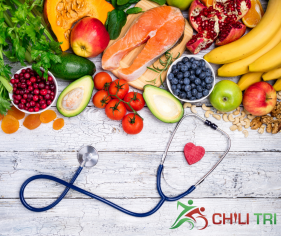
Getting Triathlete Nutrition Right using BMR & Macros
As a triathlete getting your nutrition right during your training and on race day is extremely important. During training optimising your macronutrient intake, not only the quantity but the timing, can be the difference between a wasted workout versus hitting your desired gains in power, speed or endurance. Misjudging your nutrition on race day could be a disaster and you could “bonk”, miss out on your PB, get cramp or even DNF.
A good starting point for your nutrition plan is to calculate your BMR.
Get your FREE Athlete Recipe Books
What is BMR?
Basal Metabolic Rate (or "BMR") refers to the amount of energy you use while at rest (i.e., not performing physical activity other than some internal metabolic processes, not including digestion).
It's measured in a unit of energy per unit of time and is usually given in Calories per day.
BMR calculations are useful for people who want to know how many Calories their body is burning on a daily basis without performing any type of physical activity.
In general, competitive athletes with a consistent and rigorous training regimen burn much more energy than non-athletes, even on days when these athletes don't train.
Bearing this in mind BMR is a useful first step for you to determine how many Calories you should be consuming each day. Once your BMR is calculated, it can be adjusted to more accurately account for all the Calories you as an athlete burns each day, both while exercising and at rest.
Non-athletes may use this BMR figure to workout how to go into calorie deficit to lose weight for example.
But as a triathlete you should use this to make sure you are fuelling up enough to train and perform optimally.
Note: BMR is very different from BMI (Body Mass Index). BMI is not a good measure for athletes as this only takes in to account your height and mass. For some athletes they would have a BMI of over 25 and would be defined as "overweight" which would not be the case.
How to Calculate Your BMR
The Mifflin-St Jeor equation is seen by the nutrition community today as the standard in calculating BMR. This formula changes slightly between males and females, and you can calculate it manually as below or use the ChiliTri BMR calculator.
Note there are two equations in the calculator the Mifflin-St Jeor and the Harris Benedict select the right one.
Males
(10 x weight in kilograms) + (6.25 x height in centimetres) - (5 x age in years) + 5
Females
(10 x weight in kilograms) + (6.25 x height in centimetres) - (5 x age in years) - 161
NOTE: 1 kilogram equals 2.2 pounds, and 1 centimetre equals 0.4 inches
The numerical value calculated from the equation of choice above refers to the number of Calories burned by the body on a daily basis without performing any physical activity (including normal activities like walking around or even eating and digesting food).
Normally active people usually multiply this baseline value by about 1.2- 1.7 to account for their physical activity energy needs.
But for you as an athlete, this value usually increases significantly more than for non-athletes, because athletes burn significantly more Calories every day in order to fuel the body with the nutrients and energy it needs to perform at its best. When long bouts of exercise are incorporated into the athlete's daily (or near daily) routine, this initial BMR value increases sometimes by two to three times.
If an athlete is trying to gain or lose weight, this figure will be modified (higher or lower) even more to meet those fitness goals.
NOTE: when attempting a weight-loss or weight-gain program, consult with your coaches, your doctor, and/or other experienced health professionals in order to safely and responsibly execute the demands of a dieting program. In general, it is recommended that competitive athletes not lose or gain more than 3-4 pounds of fat and/or lean muscle mass per week so their bodies perform at their best, athletically and otherwise.
Once your BMR is calculated if you are trying to maintain weight, this number may be multiplied by about 1.2 to 2.0 or even higher in certain cases, depending on your sport. Some popular sports and corresponding BMR multiple suggestions are included below:
Sport Multiplier
Triathlon 1.5 - 1.8+
Football/Soccer 1.5 - 1.8+
Track & Field 1.5 – 2.0+
Swimming 1.5 – 2.0+
Golf 1.2 – 1.5+
Cycling 1.5 – 2.0+
For example:
A 20-year-old male cyclist who is 5'10" and 170 pounds, his BMR baseline intake number would be:
(10 x 170/2.2) + (6.25 x 70/0.4) - (5 x 20) + 5 = 1772 Calories (approx)
to account for this athlete practicing 5-7 times a week or more, every day he should consume about 1.8 times the number of calories calculated by the BMR equation for men (above) to stay at his current weight.
1772 x 1.8 = 3,190 Calories (approx)
Based on this modified BMR value, the athlete can now design meal plans (daily, weekly, etc.) that meet the caloric needs of the athlete to perform at his or her best on a daily basis.
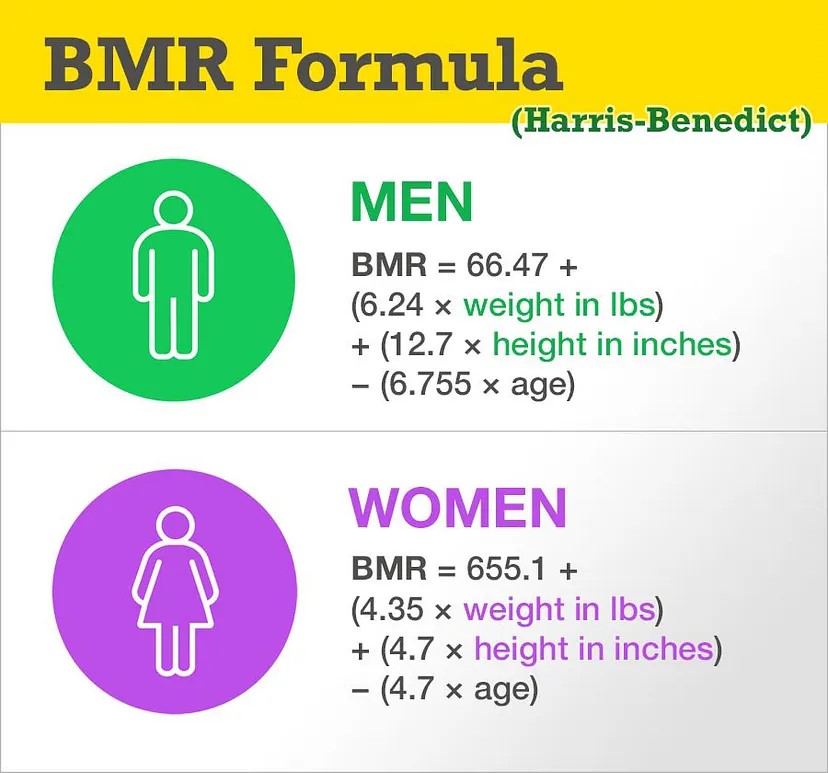
Macros and Athletes
Eating nutritious food is vital to an athlete's success on the track, turbo, road, trail, pool, etc. The trick to meal planning is recognizing bad eating habits and changing them to good eating habits. Once you get used to eating well, you will likely prefer to eat good, healthy foods instead of bad, unhealthy foods.
The benefits from a healthy diet will be evident, and should include:
- Improved athletic performances (for training AND on race day)
- Increased energy throughout the day
- Better sleep
- Improved and more stable mood
- Safer and more effective methods for desired weight loss OR weight gain
Plus, a wide range of overall health benefits, including:
- Lower blood pressure
- Reduced risk of diabetes
- Reduced risk of certain cancers
The basic idea for creating a healthy diet is balancing protein, carbs, and fat throughout the day. The body uses each of these three components for energy, depending on how long and how intensely you train, and also to build all of the cells and tissues and organs your body needs to make you strong and healthy.
You can use this Macro Calculator for athletes to calculate your needs.
Get your FREE triathlete 7-day meal plan here.
Basic Macronutrient Intake Model
- Protein 30% - 35%
- Fat 20% - 25%
- Carbs 50% - 65%
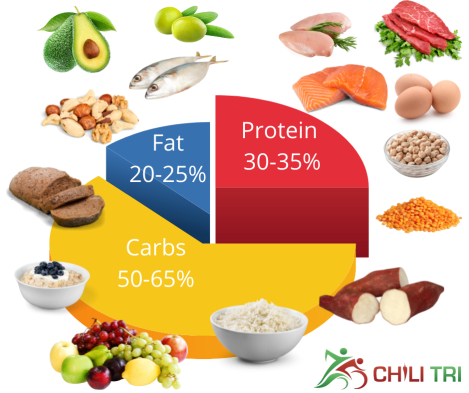
Pie Chart showing Macronutrients
Get your FREE Athlete Recipe Books
Note: If you are an older athlete, you may need more protein, read about it on the Blog about protein and the older athlete.
Protein: can be found in meats, most dairy, beans, nuts, etc.
Fat: can also be found in meats, most dairy, nuts, oils, desserts, and even some vegetables (these are usually described as "good fats").
Carbs: can be found in most anything you eat, including meat, dairy, nuts, fruits, vegetables. And anything with sugar in it (e.g., soft drinks, fruit juices, gels etc.).
Based on the macronutrient ratio above, some athletes may want to modify these proportions based on how many calories they burn each day (mainly from exercise) and/or efforts to gain or lose weight. Also, older athletes may need more protein, you can read about it here.
For instance, if a triathlete needs to take in more calories to build muscle and make sure he/she has enough energy for two-a-day workouts, he/she may want to add more protein to their diet to build muscle, and also eat more carbs and (healthy) fats so he/she has enough energy for their muscles to use during exercise without having to burn the protein in their body he/she needs to increase their muscle mass.
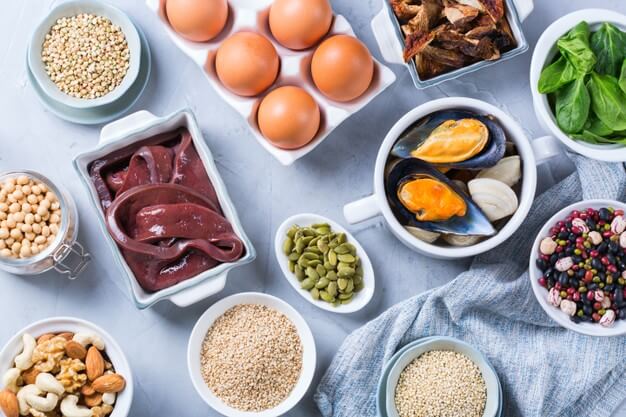
Get your FREE athlete recipe books here
All three "macronutrient" categories are needed for your body to work properly. This is why most "fad" diets do not work. Eating healthy means eating a wide variety of natural foods to give your body the range of nutrients it needs for success.
The general idea when creating a healthy meal plan is to eat as many natural (i.e., unprocessed) foods as possible. This means eating a fresh apple instead of (processed) applesauce from a can or eating a fresh fillet of fish instead of (processed) canned tuna. In general, processing foods means that nutritious elements (like vitamins and minerals) can be taken out, and unhealthy elements are added in (like sugar and fat). Indeed, some foods are more processed than others so, in general, the less processed the better.
Try to balance each meal with an appropriate ratio of protein, carbs, and fat (see above for ratio guidelines). Supplement snacks like (unprocessed) nuts and fruit to create a balanced diet providing a wide variety of healthy components, like fibre, omega-3 fatty acids, calcium and iron. The general rule is to eat 4-5 smaller meals a day (including snacks) rather than 2-3 large meals a day. The science behind this recommendation can get rather complex, but basically the body breaks down and stores food "better" when smaller portions of food are consumed as opposed to overwhelming the body with a lot of calories all at one time.
You can use this Macro Calculator for athletes to calculate your needs.
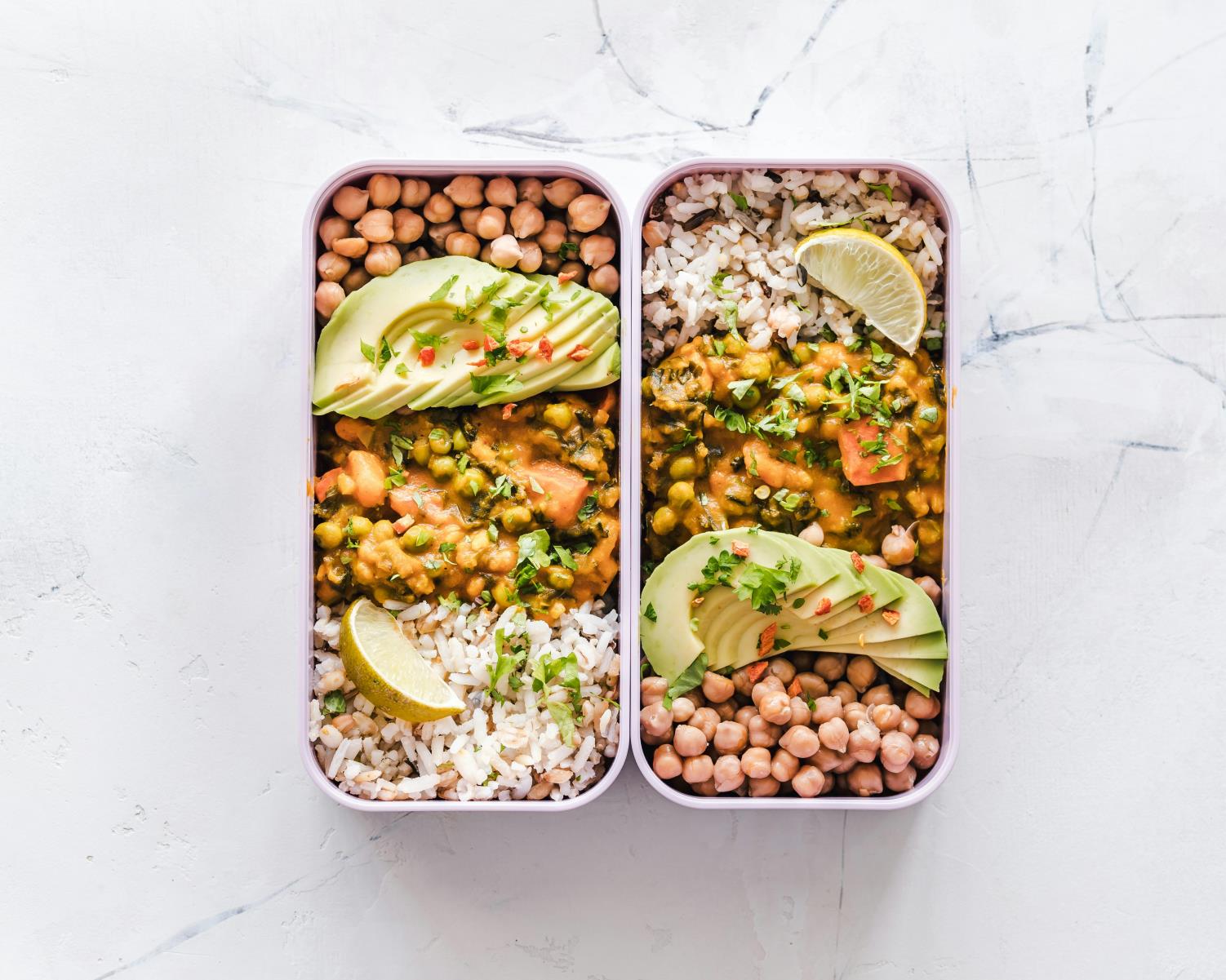
Get your FREE Athlete Recipe Books
An example of a day of smaller meals is:
Breakfast:
2-3 eggs (scrambled, poached, boiled etc.); 2-3 pcs turkey bacon; 1 cup fresh fruit; 1-2 pcs whole grain toast; 1 glass Orange Juice
Morning Snack:
1-1.5 cups nuts (almonds, pistachios, cashews, etc.), unprocessed
Lunch:
Grilled chicken breast,1-2 cups roasted sweet potatoes (cooked in extra virgin olive oil); 0.5-1 cups cooked spinach and/or broccoli; 1 glass milk or unsweetened almond milk
Afternoon snack:
1 small-large protein shake made of fresh (or flash frozen) berries, oranges, apples, bananas, raw protein isolate (whey protein mix), milk, and ice
Dinner:
1 turkey burger (6-8 oz. turkey patty, grilled; top with lots of fresh produce, like lettuce, tomato, onion, cucumber, spinach, etc.; light condiment spreads, mustard, etc.; bun made of wheat or multigrain bread or wrap it in lettuce or a non-bleached tortilla); 0.5-1 baked potato (light butter or non-fat sour cream) or 1 cup brown rice; 3-6 oz. fresh vegetable(s) of choice; 1 glass milk or water.
Liquids:
4-6 litres of water consumed throughout the day
A common misconception about healthy food is it's too expensive. True, you can spend a lot on healthy foods, but you don't have to.
Tricks for buying healthy foods on a budget include:
- Buy individual-sized servings of meat and side dishes so you don't waste food
- Examples include fruits (apples, oranges, etc.); nuts (pistachios, peanuts, etc.)
- Don't buy junk food along with healthy foods. This is especially important, so you aren't tempted to eat junk instead of the healthy food in your fridge.
- Find out when your local store puts their food on sale. Often FRIDAYS are a common day for food at stores to go on sale (just check expiration dates so you don't buy food that will expire before you eat it!)
I have put together some recipe ideas on the website.
Tracking you Macros
A quick and easy way to track and log your macros and meals is to use a free App like MyFitnessPal. MyFitnessPal is one of the most well-known food tracking apps, and it’s popular for good reason. It has a feature to track macros and a huge database of fresh and packaged foods. MyFitnessPal iOS and MyFitnessPal Android.
Conclusion: BMR and You
Start by calculating your BMR using the ChiliTri calculator to see how many calories and macros (protein, fat and carbohydrates) you need daily. By selecting your activity level, you can modify this BMR based on your training level, e.g., very active lifestyle exercising 6-7 days per week. The result will show your daily calorie need along with your macros needed to train well.
This can be used as your basis for a balanced training diet and using a tracking App will help you keep on track.
You can use this Macro Calculator for athletes to calculate your needs.
Would you like to talk about your nutrition? Get in touch here.
Get your FREE athlete recipe book.


Karen Parnell is a Level 3 British Triathlon and IRONMAN Certified Coach, 8020 Endurance Certified Coach, WOWSA Level 3 open water swimming coach and NASM Personal Trainer and Sports Technology Writer.
Karen has a post graduate MSc in Sports Performance Coaching from the University of Stirling.
Need a training plan? I have plans on TrainingPeaks and FinalSurge:
I also coach a very small number of athletes one to one for all triathlon and multi-sport distances, open water swimming events and running races, email me for details and availability. Karen.parnell@chilitri.com
Get your FREE Guide to Running Speed and Technique
Get your FREE Swim Workouts for Triathletes E-book
Get your FREE Open Water Swimming Sessions E-Book
Supplements
For completeness I should touch on supplements. At ChiliTri we prefer a "food first" approach to nutrition. If you are deficient in certain minerals like Iron then you may be prescribed a supplement by your doctor which you should follow. If you do feel you would like to take supplements remember to check them to ensure that they have been batch tested to reduce the risk of ingesting a banned substance. Age group athletes can now be tested at events so make sure you know the rules around this. The best option is to fuel your training with real food. To help with this I have put together some recipes ideas for you. If you would like more information around anti-doping please get in touch.

FAQ: BMR (Basal Metabolic Rate) and Macros (Macronutrients) for triathletes
What is BMR?
Basal Metabolic Rate (BMR) is the amount of energy (calories) your body needs to perform basic functions while at rest. It represents the energy required to maintain vital bodily functions, such as breathing, circulation, and cell production.
Why is BMR important for triathletes?
BMR is important because it provides a baseline for determining your daily calorie needs. Understanding your BMR helps you estimate the total amount of calories you need to consume to support your daily activities, including training and recovery.
How is BMR calculated?
BMR can be estimated using various formulas, such as the Harris-Benedict equation or the Mifflin-St. Jeor equation. These formulas take into account factors such as gender, age, weight, and height. Online calculators and health professionals can help you determine your estimated BMR.
What are macronutrients (macros)?
Macronutrients are the three essential nutrients that provide calories and make up the bulk of your diet: carbohydrates, proteins, and fats. Each macronutrient plays a unique role in fuelling your body and supporting athletic performance.
How do macros relate to triathlon training?
Macros play a crucial role in fuelling and supporting the high energy demands of triathlon training. Carbohydrates are the primary fuel source during intense exercise, proteins support muscle repair and growth, and fats provide energy and support various bodily functions.
How should macros be balanced for triathletes?
The optimal balance of macros varies depending on individual goals, training volume, and intensity. As a general guideline, a balanced macro distribution for triathletes may include:
- Carbohydrates: 45-65% of total calories to support energy production and glycogen replenishment.
- Proteins: 15-25% of total calories to support muscle repair and recovery.
- Fats: 20-35% of total calories to provide essential fatty acids and support overall health.
Should triathletes track their macros?
Tracking macros can be beneficial for triathletes to ensure they are meeting their nutritional needs and optimizing performance. It helps ensure an adequate intake of each macronutrient and can be particularly helpful during periods of intense training or when specific goals (e.g., weight loss, muscle gain) are targeted.
How can triathletes calculate and track their macros?
Triathletes can calculate their macros by multiplying their estimated daily calorie intake by the appropriate percentages for each macronutrient. Tracking apps and online tools can help monitor daily intake and ensure the desired macro distribution is being met. Consulting with a registered dietitian or sports nutritionist can provide personalized guidance.
Are there any other factors to consider besides BMR and macros?
Yes, other factors to consider include individual nutrient needs, training intensity and volume, race goals, body composition, and personal preferences. It's important to work with a qualified sports nutrition professional to develop a comprehensive nutrition plan tailored to your specific needs.
Remember, nutrition plays a vital role in triathlon performance, and finding the right balance of macros, calories, and nutrient timing can optimize training, recovery, and overall health.
References
BMI
https://en.wikipedia.org/wiki/Body_mass_index
BMR
https://en.wikipedia.org/wiki/Basal_metabolic_rate
Total Energy and Macronutrient Intakes in Masters Athletes
Quentin Nichols, Rohit Ramadoss, Stella Volpe: https://academic.oup.com/cdn/article/5/Supplement_2/1296/6292466
